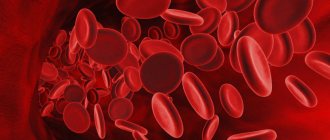The effect of progesterone in a woman’s body
The corpus luteum of the ovary is responsible for the synthesis of progesterone, which secretes it long before conception. The adrenal glands also produce small amounts of the hormone. This biologically active substance affects the favorable course of pregnancy, regulates the menstrual cycle, and stimulates protein production.
Progesterone is produced by the body during ovulation. If fertilization has occurred, its production stops in the second trimester of pregnancy. If the result is negative, the corpus luteum stops producing the hormone, is destroyed and menstruation begins.
Progesterone deficiency negatively affects the reproductive system. The fertilized egg is unable to attach to the inner layer of the uterus due to active contraction of smooth muscles. Due to a lack of the hormone, the embryo with the embryonic membrane (fertilized egg) is rejected - spontaneous termination of pregnancy.
Progesterone is responsible for the restructuring of the paired glandular organ - the breast, activating the ability to lactation. Therefore, an analysis of the level of this hormone is prescribed to a woman who is preparing to become a mother.
The value of the volumetric norm of the hormone for the body:
- prevents the rejection of the egg with the functional layer of the endometrium;
- creates favorable conditions in the uterine cavity for conception with subsequent embryonic development;
- provides support for the embryo at all stages of development.
The hormone indirectly affects metabolic processes:
- regulates blood viscosity, helping to normalize blood pressure;
- converts adipose tissue into physical energy;
- helps with the manifestation of fibrocystic mastopathy.
The level of progesterone is a kind of guarantee that menopause will not occur earlier than expected. The hormone is also responsible for reducing the unpleasant symptoms of premenstrual syndrome (PMS). Disruption of the natural balance of progesterone has negative consequences for a woman’s body. That is why gynecologists sound the alarm when they see low or too high indicators in the tests.
OH-progesterone
OH-progesterone (other names: 17-OH-progesterone, 17-OH, 17-alpha-hydroxyprogesterone, 17-OPG), contrary to popular belief, is not a hormone. It is a product of the metabolism of steroid hormones, which is secreted by the ovaries and the adrenal cortex. This is a kind of “semi-finished product” from which important hormones are formed. OH-progesterone is elevated or decreased during pregnancy A blood test during this period does not provide any useful information to the doctor. It is important what level of progesterone the baby has after birth.
OH-progesterone: normal
An analysis of the hormone concentration is taken on the 4-5th day of the cycle. This must be done 8 hours or more after the last meal. If the adrenal glands are healthy and secrete OH-progesterone in sufficient quantities, the norm in women of childbearing age should be within the following range:
- 1.24-8.24 nmol/l - follicular phase;
- 0.91-4.24 nmol/l - ovulatory phase;
- 0.99-11.51 nmol/l - luteal phase.
During menopause, the hormone level decreases to 0.39-1.55 nmol/l. It can be increased in women during pregnancy:
- I trimester - 3.55-17.03 nmol/l;
- II trimester - 3.55-20 nmol/l;
- III trimester - 3.75-33.33 nmol/l.
Lack of OH-progesterone
When the level of the hormone in the body is low, the following may occur:
- abnormal development of the external genital organs in boys (pseudohermaphroditism);
- chronic insufficiency of the adrenal cortex (Addison's disease).
Increase in OH-progesterone
At elevated levels, the following may develop:
- adrenal tumors;
- ovarian tumors;
- congenital disorders of the adrenal cortex.
Disturbances in the functioning of the adrenal cortex can manifest themselves:
- increased amount of hair in women on the face and chest;
- acne;
- menstrual irregularities;
- polycystic ovary syndrome;
- stillbirth;
- miscarriages;
- early child mortality.
Congenital adrenal cortex dysfunction (CAD) in a woman can also lead to infertility, but sometimes symptoms do not appear and pregnancy occurs without complications. If you have a decrease or increase in hormone levels, consult a specialist. With correct and timely analysis, you will be prescribed treatment that will help avoid the unpleasant consequences of the disease.
Deviation of progesterone from the norm: symptoms
Due to lack of hormone content:
- the process of release of a mature egg from the follicle (ovulation) is disrupted;
- hormonal levels change;
- there is a delay in embryonic development;
- the risk of pathological bleeding from the uterus, infections, and inflammatory processes increases;
- Chronic diseases of the female genital area are getting worse;
- there is a malfunction in the functioning of the endocrine glands (endocrine system).
The body reacts to its lack accordingly, which will be indicated by a number of characteristic symptoms:
- increased work of the sebaceous glands;
- skin rashes, acne;
- heavy discharge during menstruation;
- cycle failure (irregular periods);
- vaginal dryness, discomfort during intimacy.
When progesterone levels are below the permissible norm, PMS symptoms worsen - irritability and frequent mood swings. Due to a lack of the hormone, a woman may become depressed or suffer from insomnia.
A blood test for progesterone is mandatory for women who have reached reproductive age. The highest concentration of the hormone corresponds to the ovulatory phase of the cycle - the 14th day from the moment of menstruation.
High content is no better than a deficiency, except in cases where the cause of this phenomenon is a successful conception. Progesterone above normal may be a consequence of dysfunctional bleeding from the uterus, abnormal development of the child's place (placenta), renal dysfunction syndrome, or failure of the female cycle. The most “harmless” reason is hormonal drugs, the use of which provoked an increase in the level of progesterone in a woman’s body.
Normal for women
The values of an important sex hormone differ in different phases of the cycle. Unlike many regulators, progesterone reaches peak concentration in the second phase of the cycle, a week before the arrival of the next menstruation. It is no coincidence that doctors prescribe a progesterone test for 21 days, if the standard cycle length is 28 days.
Optimal hormone levels in non-pregnant women:
- from 1 to 15 days from 0.97 to 4.73 nmol/l,
- from 17 to 22 days from 2.39 to 9.55 nmol/l,
- from 22 to 28 days from 16.2 to 85.9 nmol/l.
During menopause, the values are lower: 0.322.51 nmol/l.
During gestation, the optimal values are higher (measurement in nmol/l):
- 1st trimester from 14.9 to 107.9,
- 2nd trimester from 61.7 to 159.0,
- 3rd trimester from 17.1 to 509.1,
- 2 days before birth, decrease the values to 2.3 nmol/l (to stimulate uterine contractions).
On a note! Progesterone increases during pregnancy: increased production of the hormone prevents contractions of the muscles of the uterine walls, ensures the emergence of maternal instinct, and prepares the breasts for natural feeding. 2 days before the onset of labor, the concentration of the hormone drops sharply: it is important that the excess of this important regulator does not interfere with the active contraction of the uterus during the birth of the child.
Normal for day 21 of cycle
It is during this period that a woman should undergo testing to clarify the values of an important sex hormone. With a regular cycle, progesterone levels are at their highest during this period. If the values are not lower than 2.30 nmol/l and not higher than 9.55 nmol/l, then there is no reason for concern: progesterone is normal. If a woman takes oral contraceptives, then the permissible level of the sex hormone will be different from 1.52, but not higher than 5.45 nmol/l.
On what day should I take progesterone? If monthly bleeding occurs irregularly, you need to count a week until the approximate arrival of the next menstruation. With a 34-day cycle, blood sampling for hormone analysis is carried out on day 27. If the period between menstruation is shorter, for example, 26 days, then a visit to the laboratory to clarify progesterone values is needed on the 19th day.
In each case, the gynecologist takes into account the duration of three to four consecutive cycles. This way you can choose the optimal day for testing for progesterone and determine the dynamics of the hormone concentration.
How to donate blood for progesterone
External factors change the research data. Therefore, you need to follow a number of rules and ask your doctor how to properly take a progesterone test:
- a week before the study, stop drinking alcohol;
- the day before the test, do not eat fatty foods, as the hormone is formed from cholesterol;
- stop all medications a week before the study; if any drug cannot be excluded due to health conditions, inform your doctor about it;
- exclude sexual activity before analysis;
- exclude any stress, physical activity;
- do not smoke on the day of the study;
- blood for progesterone is taken on an empty stomach.
Since the amount of the hormone changes during the menstrual cycle, you need to know when to take progesterone.
Blood is donated for research 3 times (7, 14, 21 days of the cycle). This technique shows in which phase the violation occurs.
Blood for progesterone is taken from a vein. It is advisable to do this in the morning. If this is not possible, intravascular fluid is collected later. But the last meal should be at least 6 hours before the test.
Functions of progesterone
The role of progesterone in a woman’s body is varied.
- It affects the production of other sex hormones and the synthesis of corticosteroids and aldosterone (produced by the adrenal glands).
- Prepares a woman’s body for conception and gestation. The endometrium prepares to receive a fertilized egg, its contractility decreases. The vaginal secretion becomes thick, which prevents the passage of sperm.
- Reduces the activity of the immune system, which reduces its activity in relation to the fetus (it acts as a foreign object for the immune system).
- Facilitation of the birth process due to a decrease in the amount of the hormone progesterone.
- Stimulates the development of mammary glands to prepare for lactation.
- Containing lactation during gestation. After childbirth, the amount of the hormone decreases, which leads to the release of colostrum and milk.
- Improves skin quality due to the presence of progesterone receptors on it. With age, the amount of the hormone decreases and wrinkles appear.
- Stimulates the production of neurohormones (allopregnanolone).
- Together with neurohormones, it stimulates brain neurons responsible for the sexual behavior of women.
Norm of progesterone by day of the cycle
The rate of progesterone in women depends on age and cycle phase. After menopause, its amount normally decreases sharply. If a woman takes birth control, the hormone increases. For pregnant women, the indicator is different.
Table of normal levels of progesterone in the blood of a healthy woman by day of the cycle.
| Cycle day | Indicator, nmol/l | Indicator when using contraceptives, nmol/l |
| 1-15 | 0,95-4,74 | Up to 3.5 |
| 16-22 | 2,4-9,56 | 1,5-5,5 |
| 23 days or more | 16,3-86,0 | 3-66,5 |
If an egg is fertilized in the female body and implanted into the endometrium of the uterus, the indicator changes.
Table of normal progesterone levels in women, characteristic of pregnancy.
| Duration, weeks | Normal amount of indicator, nmol/l |
| 1-14 | 15-108 |
| 14-28 | 61,2-158,3 |
| 28-40 | 17,4-508,3 |
Progesterone imbalance
If a woman develops body disorders associated with an increase in hormone levels, the following symptoms appear in women:
- change in skin quality (appearance of acne);
- increased hair growth on the arms, legs, face;
- weight gain for no apparent reason;
- frequent mood swings, depression;
- neuralgia: headache, nausea;
- fluctuations in blood pressure;
- disruptions of the menstrual cycle (large delays, menstruation not appearing every month);
- change in the contents of vaginal discharge (increased viscosity, bloody impurities);
- soreness of the mammary glands.
These signs are characteristic of many diseases, so the doctor explains what it is and prescribes additional tests to identify the disease and tells how to reduce progesterone.
A high level of the indicator is characteristic of pathology of the adrenal glands and disorders of egg fertilization, cancer.
- A congenital disease of the adrenal cortex that alters its function. This leads to a disruption in the release of all adrenal hormones: some of them decrease, others increase.
- Bubble drift. This is a pathology of the formation of a fertilized egg at the trophoblast stage. The rate is higher than during a healthy pregnancy.
- Malignant neoplasm of the ovaries leads to a sharp increase in the rate.
Low progesterone in women in the absence of pregnancy is determined using three blood tests or at the time of its maximum value. The hormone is synthesized mostly by the corpus luteum; its level below normal indicates its pathology.
The following symptoms appear due to low progesterone:
- the person becomes depressed and irritable;
- body weight increases;
- blood pressure is too high;
- hair fall out;
- bloating appears;
- the menstrual cycle is disrupted;
- hypersalivation (excessive sweating) appears;
- pregnancy ends spontaneously;
- vaginal discharge mixed with blood;
- hypothermia (low body temperature) with blue extremities.
If there is no ovulation, the following reasons for increased progesterone in women are identified:
- fibrosis of follicles (replacement with connective tissue);
- improper formation of the corpus luteum;
- disruption of the transition of the follicle to the corpus luteum.
If ovulation persists, the reasons for low progesterone include:
- an increase in the rate of formation of the corpus luteum of the ovary after ovulation, during which the hormone does not have time to form;
- constant stress;
- a sharp decrease in body weight;
- excessive physical activity.
In a healthy pregnancy, the amount of progesterone increases with increasing pregnancy, that is, its peak is reached in the third trimester. The decrease in the indicator during gestation depends on its duration:
- up to 16 weeks the cause is the corpus luteum (it produces a hormone);
- after 16 weeks, the placenta develops and the production of indicators inside it begins.
There are diseases that develop as a consequence of influence on the body.
- Benign neoplasms (uterine fibroids, formations in the mammary glands).
- Chronic miscarriage. A reduced amount of progesterone stimulates the contraction of smooth muscles, so the development of the embryo does not occur, and it is rejected from the uterus.
The role of progesterone levels for successful conception
The hormone progesterone got its name from the addition of two words of Latin origin: “pro” - in favor, and “gestatio” - pregnancy, carrying. That is why it is also called the pregnancy hormone. Progesterone is of great importance in the process of implantation (attachment), growth of the fertilized egg and its development, and also plays an important role in the success of pregnancy. If its content in the body is insufficient (below the norm), then a delay in the development of the fetus and even termination of pregnancy is possible. If the level of progesterone in the blood exceeds the permissible norm, this means the presence of diseases of the female reproductive system.
The hormone progesterone is produced much earlier than the moment of conception. It is actively produced by the so-called corpus luteum in a woman’s ovaries from the moment of ovulation until the sixteenth week of pregnancy. If fertilization of the egg does not occur, then the corpus luteum dies and another menstruation begins. The pregnancy hormone is of great importance for the successful conception of a child, since it has a significant effect on the woman’s body as a whole and prepares it for reproduction (reproduction). Progesterone allows the fertilized egg to attach to the wall of the uterus. The body would reject the fertilized egg if there were no progesterone. This hormone has the ability to reduce the activity of uterine contractions, thereby minimizing the risk of miscarriage - involuntary termination of pregnancy. In addition, progesterone “tunes” the mammary glands to produce milk.
See also: Stop smoking before pregnancy!
Blood progesterone level
The level of progesterone in the female body fluctuates noticeably, which directly depends on the phase during the menstrual cycle. The level of the hormone increases during the first phase of the cycle, reaching its highest level immediately during ovulation. If pregnancy occurs after ovulation, the level of progesterone continues to increase, thereby providing the necessary conditions for the further development of the fertilized egg and, accordingly, for maintaining the resulting pregnancy. If pregnancy does not occur, then the level of progesterone will drop to its value in the so-called pre-ovulatory phase of the menstrual cycle, which will lead to the onset of the next menstruation. In a healthy woman, the second phase of the menstrual cycle (postovulatory) should last at least ten days. During this time, the corpus luteum of the ovary secretes progesterone, which prepares the endometrium (the mucous inner layer of the uterus) for the expected onset of pregnancy. In this regard, a reduction in the duration of the second (luteal) phase (the so-called luteal insufficiency) leads to the following consequences: the endometrium does not have time to prepare to accept the fertilized egg, as a result of which pregnancy does not occur. Insufficient progesterone levels can also lead to arbitrary termination of pregnancy (miscarriage) in the early stages, since its reduced concentration does not create the opportunity to maintain the normal state of the endometrium necessary for the development of the fertilized egg. The normal level of progesterone in the blood is as follows:
For women of reproductive age:
- before ovulation – from 0.33 to 2.25 nmol/l;
- on the day of ovulation – from 0.45 to 9.45 nmol/l;
- after ovulation (at pregnancy) – from 6.9 to 56.6 nmol/l.
For pregnant women:
- in the first trimester – from 8.91 to 468.5 nmol/l;
- in the second trimester – from 71.2 to 303.0 nmol/l;
- in the third trimester – from 88.6 to 771.6 nmol/l
In addition to the functions of successful conception and further maintenance of the resulting pregnancy, progesterone also performs other functions. For example, it prevents the possibility of the formation of fibrous cysts, helps the body transform fat tissue into energy, normalizes blood viscosity and helps maintain normal blood sugar levels. It has been scientifically proven that the development of menopausal and premenstrual syndromes is associated not only with the level of estrogen concentration, but also with a deficiency of the hormone progesterone . In connection with the above, it can be argued that a normal level of progesterone in the blood of every woman is important not only when pregnancy is planned, but also for the normal functioning of the entire body.
See also: Vitamins before planning pregnancy
When is it necessary to take a blood test for progesterone?
Before you start planning for the future conception of a child, you will need to contact specialists and undergo the necessary tests, including an analysis of progesterone levels. Knowing your doctor's progesterone levels will help you avoid negative factors during pregnancy. This will also help avoid unsuccessful attempts to conceive. An analysis of levels is prescribed in the following cases: irregularities in the menstrual cycle (to determine the causes); to establish the causes of infertility if ovulation is preserved; to monitor the patient if she has induced ovulation.
In order for the tests to show the most correct result, you must strictly follow the doctor’s instructions. Firstly, it is best to donate blood on an empty stomach in the morning (at least eight hours after the last meal). Secondly, this analysis is taken on certain days of the cycle. In a normal 28-day cycle, a progesterone test is taken on the 22nd or 23rd day of the cycle. If the cycle is not regular, several days are prescribed for taking this test on the days indicated by the doctor.
If a deviation in the progesterone level from the established norm is detected, the doctor will prescribe medication (hormonal drugs) to adjust the progesterone concentration. In this case, the course is selected exclusively individually, guided by test results and a picture of the general condition of the patient’s body. Before determining any treatment regimen for you, your doctor should tell you about all the positive and negative aspects of hormone therapy.
In cases of treatment with hormones, you should not self-medicate! Hormonal drugs that increase (lower) progesterone levels (as, indeed, all others) can affect your entire body, not just your reproductive system. They have certain strict indications for use, as well as many contraindications, and by independently prescribing treatment, you can achieve the completely opposite positive result.
See also: Balanced diet before pregnancy
Related articles on the topic:
- Individual conception calendar
- Development of the embryo after conception
TAKE THE TEST (8 questions):
HOW JEALOUS ARE YOU? (one more test!)
What is progesterone
The hormone progesterone is formed from cholesterol, which undergoes a series of biochemical reactions. It is secreted by the corpus luteum (a temporary formation that is released after ovulation) and the adrenal glands. If a woman becomes pregnant (gestation), the functions of the corpus luteum include the release of progesterone in excess. The tissue of the uterus and its vascular supply increases.
Important! During gestation, the initial stage of hormone synthesis occurs inside the placenta, the rest of the process is completed in the fetus.
In the later weeks of pregnancy, progesterone is synthesized by the placenta. A higher progesterone content is necessary to maintain gestation and increase uterine nutrition.
Progesterone is produced under the influence of luteotropic hormone. Its amount depends on the phase of a woman’s menstrual cycle. The maximum peak occurs in the period after ovulation (luteal phase). By the end of the cycle, its number reaches a minimum concentration.
Only a small amount of progesterone is in a free state, the rest forms a complex with proteins.
The substance is excreted through the kidneys.











